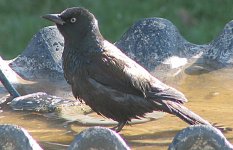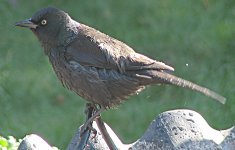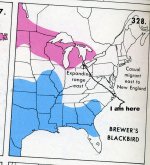Hello Al, Chris and Halftwo,
When I look at this bird (looking mainly at the second photo), I see:
1. A round head with a steep forehead, that is distinctly brown in the lores and the crown.
2. A bill that is within range for Brewer's (see 3 of the 5 birds in the link below). This is particularly true as being wet can depress feathers, and make the bill look relatively larger.
http://roysephotos.com/BrewersBlackbird.html
3. A tail that would be short for Grackle -- but just right for Brewer's.
4. A bit of a rotund appearance to the body, again better for Brewer's.
5. A concentration of what iridescence we can see around the wing coverts, and just above and below (see photo below).
http://www.miriameaglemon.com/photogallery/Brewer's%20Blackbird%20YM%20Henshaw.jpg
6. An observer who in the field and at close range thought the bird was noticeably smaller than a Common Grackle.
When I add 1 through 6 up, they don't sum up to Common Grackle for my vote. There is a stronger case for Brewer's in my opinion.
(I certainly don't want to make a habit of disagreeing with Chris, as that would mean that I would usually be wrong, but this bird did cry out for a bit of the old devil's advocate counterpoints.)






